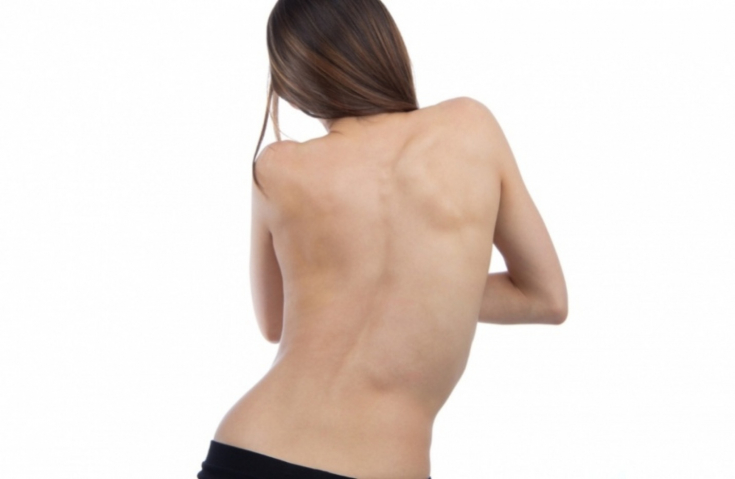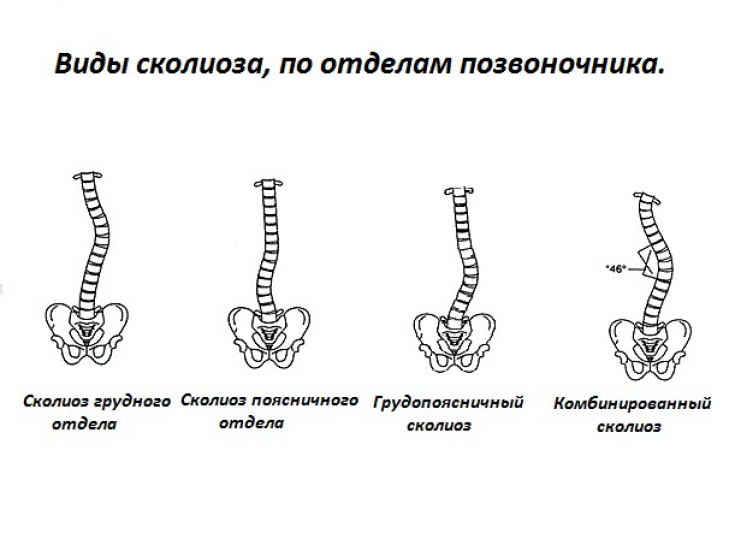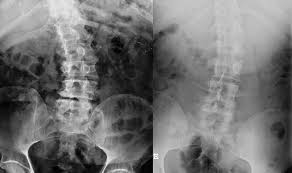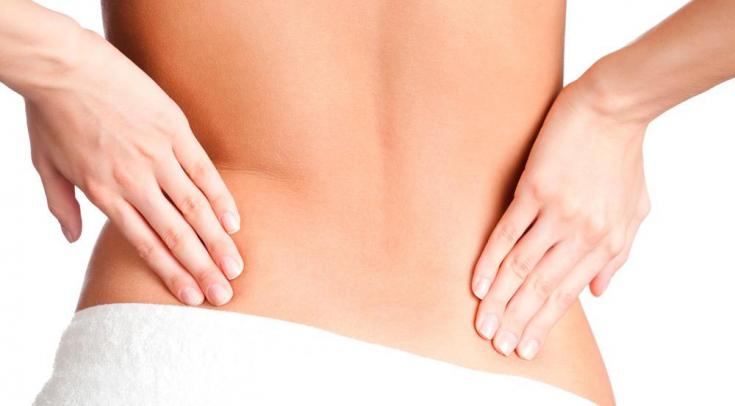The processes of spinal deformity are increasingly affecting both adults and children. The cause of diseases is excessive physical activity, congenital diseases of the musculoskeletal system, lack of necessary physical activity. The most common vertebral curvature – scoliosis affecting several departments at once.
Lumbar Scoliosis – a pathology in which there is a lateral deviation of the spine, it takes the form of the letter S. The disease is characterized by shortening of one lower limb, asymmetry of the waist. At the initial stage, it is not noticeable, does not bring any discomfort, but progresses rapidly. Causes pathology of other nearby organs. Allocate left-sided and right-sided scoliosis of the lumbar.
Symptoms and diagnosis of lumbar scoliosis
- Lumbar Scoliosis – causes and severity
- Treatment of lumbar scoliosis
- spine Symptoms and diagnosis of lumbar scoliosis At the first stages of development, visually, the deformation of the spine is not noticeable, there is no specific clinical picture. With further development, changes in the waist area are highlighted – unilateral appearance of the muscle roller.
Follow us on
Instagram!
First symptom – pain in the lumbar region, during the transition of the disease to stage 3, there are such signs:
• restriction of motor activity, soreness of the spinal muscles;
• asymmetry of the pelvic bones, they are shifted to one side;
• occurrence of osteochondrosis, spinal hernia;
• muscle weakness in the lumbar region, kyphosis;
• change in posture, pain radiating to the legs when walking.

Lordosis and kyphosis: what you need to know about the enemies of posture similar
symptoms,
contact a specialist for help. An orthopedist, surgeon, traumatologist are competent in this matter. For the correct diagnosis, you will be prescribed: a general blood test, urine, X-ray, MRI, ultrasound of internal organs, examination for the state of muscle tone. These examinations will help the doctor determine in which department the lesion is located, what is its degree, what treatment to apply. A CT scan will show a three-dimensional image of the affected area, with minimal risk of radiation exposure. MRI – an expanded picture of each tissue layer.
During the examination, the doctor will most likely find a distinct deep triangle of the waist and a protruding iliac crest of the pelvic bone. The place of the greatest twisting of the spine is indicated by a muscle roller in the middle part of the lower back, found on palpation. With lumbar scoliosis, osteochondrosis often develops, treatment is aimed at reducing pain and reducing the risk of complications.
causes of scoliosis
what is its degree, what treatment to apply. A CT scan will show a three-dimensional image of the affected area, with minimal risk of radiation exposure. MRI – an expanded picture of each tissue layer.During the examination, the doctor will most likely find a distinct deep triangle of the waist and a protruding iliac crest of the pelvic bone. The place of the greatest twisting of the spine is indicated by a muscle roller in the middle part of the lower back, found on palpation. With lumbar scoliosis, osteochondrosis often develops, treatment is aimed at reducing pain and reducing the risk of complications.
causes of scoliosis what is its degree, what treatment to apply. A CT scan will show a three-dimensional image of the affected area, with minimal risk of radiation exposure. MRI – an expanded picture of each tissue layer.During the examination, the doctor will most likely find a distinct deep triangle of the waist and a protruding iliac crest of the pelvic bone. The place of the greatest twisting of the spine is indicated by a muscle roller in the middle part of the lower back, found on palpation. With lumbar scoliosis, osteochondrosis often develops, treatment is aimed at reducing pain and reducing the risk of complications.
During the examination, the doctor will most likely find a distinct deep triangle of the waist and a protruding iliac crest of the pelvic bone. The place of the greatest twisting of the spine is indicated by a muscle roller in the middle part of the lower back, found on palpation. With lumbar scoliosis, osteochondrosis often develops, treatment is aimed at reducing pain and reducing the risk of complications.
 causes of scoliosis
causes of scoliosis
A CT scan will show a three-dimensional image of the affected area, with minimal risk of radiation exposure. MRI – an expanded picture of each tissue layer.During the examination, the doctor will most likely find a distinct deep triangle of the waist and a protruding iliac crest of the pelvic bone. The place of the greatest twisting of the spine is indicated by a muscle roller in the middle part of the lower back, found on palpation. With lumbar scoliosis, osteochondrosis often develops, treatment is aimed at reducing pain and reducing the risk of complications.
causes of scoliosis
an expanded picture of each tissue layer.During the examination, the doctor will most likely find a distinct deep triangle of the waist and a protruding iliac crest of the pelvic bone. The place of the greatest twisting of the spine is indicated by a muscle roller in the middle part of the lower back, found on palpation. With lumbar scoliosis, osteochondrosis often develops, treatment is aimed at reducing pain and reducing the risk of complications.
causes of scoliosis
an expanded picture of each tissue layer.During the examination, the doctor will most likely find a distinct deep triangle of the waist and a protruding iliac crest of the pelvic bone. The place of the greatest twisting of the spine is indicated by a muscle roller in the middle part of the lower back, found on palpation. With lumbar scoliosis, osteochondrosis often develops, treatment is aimed at reducing pain and reducing the risk of complications.
causes of scoliosis

causes of scoliosis
The place of the greatest twisting of the spine is indicated by a muscle roller in the middle part of the lower back, found on palpation. With lumbar scoliosis, osteochondrosis often develops, treatment is aimed at reducing pain and reducing the risk of complications.
causes of scoliosis
Lumbar Scoliosis – causes and severity
There are 3 degrees of severity of the development of the disease:
1. First Degree – the spine deviates to the side up to 10 degrees, twisting is not visually determined, but can be seen on the picture;
– the presence of a small hump, the spine is curved to one side at an angle of up to 25 degrees, which is clearly visible both on the x-ray and with the naked eye; 
3. Third Degree – a large hump is formed, the spinal column is bent at an angle of up to 40 degrees;
4. Fourth degree
– the figure is disfigured, a hump appears on the ribs, the pelvic bones and chest are deformed, angle of curvature up to 90 degrees.
You can
check
yourself and your loved ones for symptoms of scoliosis. To do this, put a person with his back to the wall, in the absence of deformations, when touching the wall, the silhouette of the spine forms a concave line in the region of the neck and lower back, a convex line in the place of the chest and pelvis. The distances that remain between the wall and the spine at the location of the neck and waist should exactly equal the thickness of the subject's palm. In case of violations, they will be more.
the silhouette of the spine forms a concave line in the region of the neck and lower back, a convex line in the place of the chest and pelvis. The distances that remain between the wall and the spine at the location of the neck and waist should exactly equal the thickness of the subject's palm. In case of violations, they will be more.
the silhouette of the spine forms a concave line in the region of the neck and lower back, a convex line in the place of the chest and pelvis. The distances that remain between the wall and the spine at the location of the neck and waist should exactly equal the thickness of the subject's palm. In case of violations, they will be more.
Next method: feel for the 7th vertebra in the neck that sticks out. Hang any small object on a thread that will serve as a weight, and attach it to the vertebra. If it runs along the line of the spine and further between the buttocks, then everything is fine with you. In another case – this is the initial stage of lumbar scoliosis. Scoliosis should be treated before the age of 15, this age is characterized by the closure of the growth zones of the vertebrae. Then you can only stop the development of deformation. You don’t need to do exercises on your own, because some of them are strictly prohibited in case of illness.
Treatment of scoliosis of the lumbar spine
The decision onthe method of treatment is made by the doctor based on the examination. In situations with a curvature of up to 25 degrees, the disease is monitored until the end of the period of bone formation, passing x-rays every six months. With from 25-45 degrees, a corset is prescribed, which stops the development of curvatures. Scientists say that such lesions of the spinal column in adulthood are rare.
Deformation of more than 60 degrees develops in both adults and children. In this case, an operation is indicated that stops the growth of curvatures and gives a cosmetic effect. The metal construction allows you to straighten the spine.Congenital pathologies are more difficult to treat. Adolescents and adults with stage 3-4 scoliosis, most often resort to surgery. The effectiveness of treatment depends on compliance with all the rules: correct posture, alternation of physical activity and rest, timely seek advice from a specialist. Recommendations for the formation of an even posture:• it is recommended to sleep on a hard bed, an ideal orthopedic pillow and mattress;• tight shoes and clothes provoke abnormal growth of the chest and flat feet; • bag on one handle – a direct path to scoliosis, choose backpacks with wide straps;• for a student, good lighting and furniture are required, desks are recommended, behind which the child will reach the floor with his feet. Watch us on YouTube:





Add a comment